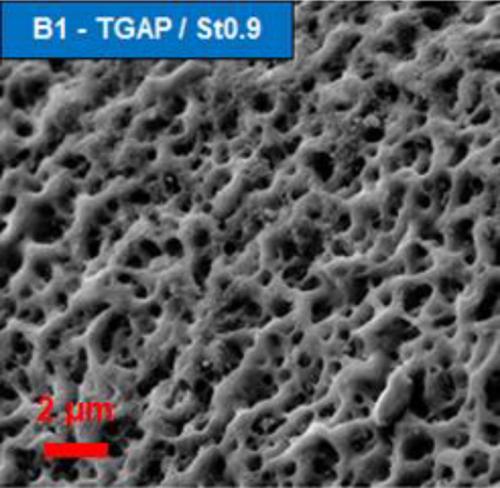当前位置:
X-MOL 学术
›
J. Polym. Sci. A Polym. Chem.
›
论文详情
Our official English website, www.x-mol.net, welcomes your
feedback! (Note: you will need to create a separate account there.)
Thermoset modified with polyethersulfone: Characterization and control of the morphology
Journal of Polymer Science Part A: Polymer Chemistry Pub Date : 2020-03-07 , DOI: 10.1002/pol.20190286 Eléonore Mathis 1 , Marie‐Laure Michon 2 , Claude Billaud 3 , Pauline Grau 2 , Anthony Bocahut 2 , Caroll Vergelati 1 , Didier R. Long 1
Journal of Polymer Science Part A: Polymer Chemistry Pub Date : 2020-03-07 , DOI: 10.1002/pol.20190286 Eléonore Mathis 1 , Marie‐Laure Michon 2 , Claude Billaud 3 , Pauline Grau 2 , Anthony Bocahut 2 , Caroll Vergelati 1 , Didier R. Long 1
Affiliation

|
Thermoset (TS) epoxy resins can be toughened with a thermoplastic (TP) for high‐performance applications. The final structure morphology has to be controlled to achieve high mechanical properties and high impact resistance. Four polyethersulfone‐modified epoxy resins are considered. They consist of different epoxy monomer structure (TGAP, triglycidyl‐p‐aminophenol and TGDDM, tetraglycidyl diaminodiphenylmethane) and a fixed amount of thermoplastic, and they are cured with two different amounts of curing agent. A reaction‐induced phase separation occurs for all formulations generating morphologies, different in shapes and scales. The aim is to control the final morphology and in particular its dominant length scale. This morphology depends on the phase separation process, from the initiation to its final stage. The initiation relies on the relative miscibility of the components and on the stoichiometry between epoxy and curing agent. The kinetics depends on the viscosity of the systems. The different morphologies are characterized by electron microscopy or neutron scattering. Dynamic mechanical analysis allows confirming the presence of a phase separation even when it is not observable by electron microscopy. Vermicular morphologies with few hundreds nanometer width are obtained for the systems containing the TGAP as epoxy monomer. Systems formulated with TGDDM presents morphologies on much smaller scale of order a few tens of nanometers. We interpret the different sizes of the morphologies as a consequence of a larger viscosity for the TGDDM systems as compared to the TGAP ones rather than by a latter initiation of phase separation.
中文翻译:

聚醚砜改性的热固性塑料:形貌的表征和控制
热固性(TS)环氧树脂可以用热塑性塑料(TP)增韧,以用于高性能应用。必须控制最终的结构形态,以实现高机械性能和高抗冲击性。考虑了四种聚醚砜改性的环氧树脂。它们由不同的环氧单体结构的(TGAP,triglycidyl- p-氨基苯酚和TGDDM,四缩水甘油基二氨基二苯甲烷)和固定量的热塑性塑料,并用两种不同量的固化剂进行固化。反应诱导的相分离发生在所有产生形态,形状和比例不同的制剂中。目的是控制最终的形态,尤其是其主要长度尺度。这种形态取决于从开始到最终阶段的相分离过程。引发取决于组分的相对混溶性以及环氧树脂和固化剂之间的化学计量关系。动力学取决于系统的粘度。不同的形态通过电子显微镜或中子散射来表征。动态力学分析允许确认相分离的存在,即使无法通过电子显微镜观察到也是如此。对于包含TGAP作为环氧单体的体系,获得了几百纳米宽度的蠕虫形貌。用TGDDM配制的系统呈现的形貌要小得多,只有几十纳米。我们解释了形态的不同大小,这是因为与TGAP相比,TGDDM系统的粘度更大,而不是后来的相分离引发。
更新日期:2020-03-09
中文翻译:

聚醚砜改性的热固性塑料:形貌的表征和控制
热固性(TS)环氧树脂可以用热塑性塑料(TP)增韧,以用于高性能应用。必须控制最终的结构形态,以实现高机械性能和高抗冲击性。考虑了四种聚醚砜改性的环氧树脂。它们由不同的环氧单体结构的(TGAP,triglycidyl- p-氨基苯酚和TGDDM,四缩水甘油基二氨基二苯甲烷)和固定量的热塑性塑料,并用两种不同量的固化剂进行固化。反应诱导的相分离发生在所有产生形态,形状和比例不同的制剂中。目的是控制最终的形态,尤其是其主要长度尺度。这种形态取决于从开始到最终阶段的相分离过程。引发取决于组分的相对混溶性以及环氧树脂和固化剂之间的化学计量关系。动力学取决于系统的粘度。不同的形态通过电子显微镜或中子散射来表征。动态力学分析允许确认相分离的存在,即使无法通过电子显微镜观察到也是如此。对于包含TGAP作为环氧单体的体系,获得了几百纳米宽度的蠕虫形貌。用TGDDM配制的系统呈现的形貌要小得多,只有几十纳米。我们解释了形态的不同大小,这是因为与TGAP相比,TGDDM系统的粘度更大,而不是后来的相分离引发。











































 京公网安备 11010802027423号
京公网安备 11010802027423号